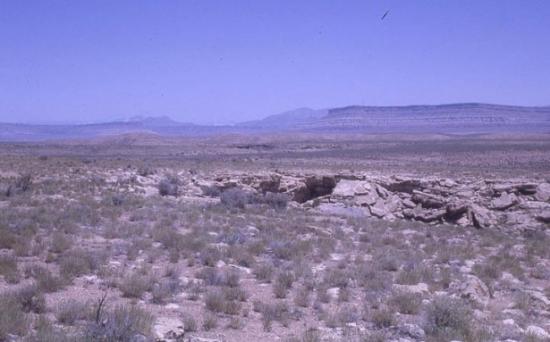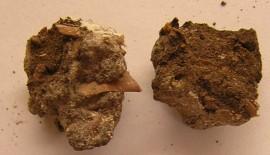Eisa Ulen Richardson
Source - http://indiancountrytodaymedianetwork.com/2012/08/23/study-of-remains-of-the-pueblo-reveals-causes%E2%80%94and-possible-cures%E2%80%94for-diabetes-epidemic-130651
 Courtesy Professor Keith Johnson - The Antelope Cave provided samples from several Southwestern tribes.
Courtesy Professor Keith Johnson - The Antelope Cave provided samples from several Southwestern tribes.
The future health of Natives may lie in the scatological remains of the past—a vanguard study of ancient excrement has offered fresh new ways of thinking about the prevalence of diabetes among Native people of the American Southwest.
Karl Reinhard, a professor of forensic science and environmental archaeology at the University of Nebraska-Lincoln, has studied the fossilized feces, or coprolites, of ancestral Pueblo people and documented typical Pueblo diets prior to European contact. He has determined that the overwhelming prevalence of diabetes among Pueblo descendants may stem from their radical departure from the healthy diets of their progenitors. According to his research, high diabetes rates might be caused by what Native Americans eat—not by how much they eat.
Reinhard studied the coprolites of Natives whose living descendants include the Hopi and Paiute. His scholarly article, Understanding the Pathoecological Relationship Between Ancient Diet and Modern Diabetes Through Coprolite Analysis, published in a recent issue of the journal Current Anthropology, identifies several Southwestern Native American tribes who have high levels of diabetes, among them the Akimel O’odham (Pima), Tohono O’odham (Papago), Quechan (Yuma), Ak-Chin (Maricopa), Hualapai, Mojave, and Zuni, as well as New Mexico Pueblo tribes. His team examined fossilized feces recovered from Antelope Cave, Mojave County, Arizona. “I think,” Reinhard says, “that the subsistence shown in the coprolites was typical of descendants of tribes in the southern Great Basin cultural area.”

The ancient diet included pigweed flowers, amaranth and sunflower seeds. (Thinkstock)
The major foods found in the coprolites were maize, wild grass, wild grass seeds and prickly pears. According to Reinhard, “The Antelope Cave diet is a high-fiber diet.” The major meats were rabbit and deer. Prickly pear seeds contain calcium, potassium, magnesium, phosphorous and fatty acids. The prickly pear pads provide iron, vitamin A in the form of beta-carotene, vitamin C and amino acids, in addition to calcium, potassium and magnesium. The wild grasses provided carbohydrates and fiber. Fiber was also abundant in the sunflowers, amaranth and pigweed of the Antelope Cave diet. It was a diet consisting of foods low on the glycemic index (GI), used to measure the effect of carbohydrates on blood-sugar levels. Foods with a high GI number are associated with heart disease and cancer as well as diabetes. “Traditional foods of the Americas,” Reinhard says, “have very low glycemic indices compared to the foods of industrialized societies.”
Because of forced relocation, these once healthy Natives had no choice but to eat unhealthy, government-subsidized foods heavy in refined sugar and white flour. Reinhard’s research suggests that, if the ancient people who lived in the Southwest hadn’t eaten so well 400 to 500 years ago, their descendants would actually be less prone to diabetes today. “The subsidies are a sort of slow poison for Native Americans,” he says.
“Eating healthy, high-fiber, low-GI foods kept people in healthy balance,” Reinhard adds. “If they had been able to continue with those healthy diets, uninterrupted by colonialism, they would be the epitome of health. The imposition of the industrialized society diet, especially the commodities program, led them down the path of ill-health for the past four generations.”
According to Reinhard, the high-fiber foods so prevalent in the Antelope Cave diet help lower variance in blood-sugar levels. By regulating blood sugar, fiber may also reduce glucose and insulin levels in diabetic patients and lower the risk of diabetes in nondiabetics. “The public health people recommend 38 grams [of fiber] per day for men [under 50] and 25 grams per day for women [under 50],” he says. “The general population consumes far less.”
While high-fiber, low-GI foods like the wild plants contained in the Antelope Cave diet would be good on tonight’s dinner table, Reinhard concedes that meals like wild plant seed and rabbit stew would also be “very hard to find in some places.” But, he adds, “newer traditional foods like frybread are not healthy.” According to his study, one modern traditional meal of the Pima, acorn and venison stew, is similar in nutrient value to ancient traditional meals and might offer life-saving food alternatives to American Indians struggling with diabetes and prediabetes today.
Indeed, one of Reinhard’s assertions is that choosing high-quality traditional foods might be more essential to the control and
reduction of diabetes in Native populations than choosing a low quantity of lower-quality processed foods. In other words, just eating less isn’t good enough.
Health-care professionals theorize that a fat-hoarding thrifty gene evolved in humans as a response to cycles of feast and famine in ancient times. This thrifty gene, which lingers in modern humans, is blamed for our tendency to clean our plates at mealtime, regardless of the amount of food piled there. The thrifty gene, more than any goodness in taste, compels people to consume large quantities when presented with a full plate of convenient and, too often, low-fiber, high-GI foods. Reinhard’s work suggests that in Natives this gene may not have developed not because of how much they ate, but because of what was eaten.
This thrifty gene, he says, “is an old term that has been generalized to a very broad metabolic phenomenon. I think that all people in the world more than 15,000 years ago had a very high-fiber, low-fat diet.” He adds, “for millions of years, all people were very good at extracting nutrients from this diet of very low-GI foods and the ‘thrifty’ metabolism was evolutionary beneficial. As people in different parts of the world began domesticating grains, a new diet emerged in some areas and the very efficient digestive/metabolic system was no longer evolutionarily adaptive. Rice, wheat, and other cereal grain products provided high-carbohydrate, moderate-GI foods. Industrial societies were able to produce even higher-GI foods and offer them cheaply to everyone. No one is evolutionarily adapted to this new dietary development. Therefore, diabetes is emerging everywhere. It emerged in First Nation societies first, along with Pacific Island societies and Australian Aborigines. These societies, by virtue of continuing a low-GI diet into the 20th century, were most at risk of the diabetes-obesity epidemic.”
Despite his emphasis on the quality of foods consumed, Reinhard recognizes that portion control and exercise are still essential in reducing the diseases prevalent in industrialized societies, including cardiovascular disease as well as obesity and diabetes. “People living traditional lifeways had an energy balance that was defined by high activity and marginal diet,” Reinhard asserts. This “energy balance” is essential when thinking about the health of modern humans.

Coprolites from Antelope Cave tell an amazing story.
“The metabolism [of ancient peoples] developed to store calories for times when calories were not available in the diet,” he explains. “In modern times, activity declined and there was no longer a precarious access to calories. Therefore, the system of balance was lost and people stored energy in the form of fat that they no longer needed because activity declined.”
Diabetics and health-care providers working with people struggling with diabetes can now use the work of paleo-nutrition researchers like Reinhard to better understand what he calls “the past human experience with food.”
“I think we will demonstrate conclusively,” Reinhard says, “that no human population is adapted for the very rapid change in diet that came at the middle of the 20th century and continues to now. The work will show that fiber was not a luxury to ancient people, it was a daily part of normal diet. In contrast, fat and sugars were luxuries in ancient times. The daily consumption of these in modern times is totally inconsistent with all of human evolution.”
In another scholarly article Reinhard authored, he explains that the study of coprolites is only about 100 years old. This area of research is not considered exciting, as it often consists of long hours staring through a microscope at a desiccated object that will never be deemed worthy of display in a museum. Yet this unglamorous field of study has the potential to fuel a revolutionary new way of thinking about diet, diabetes and overall wellness in Native communities of the Southwest and potentially elsewhere.
“I think that coprolite analysis is particularly relevant to Native Americans,” Reinhard says. “There is a record now of 11,000 years of dietary behavior from coprolites. Many studies can be linked to descendant tribes. Diabetes counseling centers should take a look at the data and develop analog diets for modern people. Soon, we will push that record back to 14,000 years. This is a unique opportunity for Southwestern tribes.”